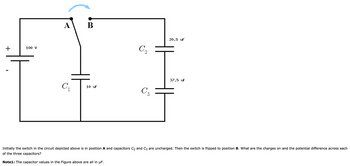Question

Transcribed Image Text:+
100 V
A B
C₁
10 uF
C₂
C₂
20.5 UF
37.5 uf
T
Initially the switch in the circuit depicted above is in position A and capacitors C₂ and C3 are uncharged. Then the switch is flipped to position B. What are the charges on and the potential difference across each
of the three capacitors?
Note1: The capacitor values in the Figure above are all in µF.
Expert Solution
arrow_forward
Step 1
we have C1= 10 C2= 20.5 C1= 37.5
V=100v
Step by stepSolved in 2 steps

Knowledge Booster
Similar questions
- 按ESC | 即可退出全屏模式 Gas insulation is important for transmission lines, outdoor insulators and Gas-insulated- Substations (GIS). Understanding the breakdown mechanisms and behaviour of insulation materials is key to the optimum design of insulation systems. The speed distribution function of electrons in a gas containing electrons, ions and atoms is controlled by the electric field strength, E, and can be expressed as fo (E, v). It satisfies the relationship of (E, v) dv=1. i) ii) Convert the above electron speed distribution function into an electron energy distribution function that satisfies the relationship f(E, ɛ) dɛ =1 where & is the electron energy and ƒ(E, ɛ) the electron energy distribution function. The electron number density is ne and the atom number density is na in the gas. The ionisation cross section of the atoms by electron impact is a function of electron energy, ɛ, and can be written as σ¡ (ɛ). Similarly, the attachment collision cross section between an electron and an…arrow_forwardDetermine the energy stored by C4, given that C1 = 20 µF, C2 = 10 µF, C3 = 14 µF, C4 = 30 µF and VO = 40 V. C4 Vo E4 = 1.70 mJ O E4 = 4.06 mJ E4 = 3.84 mJ E4 = 2.57 mJarrow_forward2) An electron is accelerated from rest through a voltage difference of 50.0V. What is its final speed? (me = 9.2 x 10-31kg) %3D O 6.2 x 10^7 m/s None of the options listed O 1.2 x 10^8 m/s O 7.2 x 10^9 m/s O 4.2 x 10^6 m/sarrow_forward
- Q. A silver wire 2.6 mm in diameter transfers a charge of 420 C in 80 min. Silver contains 5.8x10283 free electrons per cubic meter. What is the magnitude of the drift velocity (in x 10-6 m/s) of the electrons in the wire? (e = 1.60 x 10-19C) A D 1.78 2.78 3.36 4.50 5.30arrow_forwardA block in the shape of a rectangular solid has a cross-sectional area of 4.00 cm^2 across its width, a front-to-rear length of 5.00 cm, and a material conductivity of 10^6 Ω x m^-1. The block’s material contains 5.00x10^22 conduction electrons/m^3. A potential difference of 35.0 V is maintained between its front and rear faces. Find: (a) the resistivity of the block material(b) the resistance of the block(c) the current through the block(d) the magnitude of the current density if it is uniform(e) the drift velocity of the conduction electrons (f) the magnitude of the electric field through the blockarrow_forwardA room with 2.9-mm-high ceilings has a metal plate on the floor with V = 0V and a separate metal plate on the ceiling. A 1.1 g glass ball charged to 4.9 nC is shot straight up at 5.0 m/s . How high does the ball go if the ceiling voltage is −2.8×106 V ?arrow_forward
- How much energy is stored in 1.00 m3 of air due to the “fair weather” electric field of magnitude 150 V/m?arrow_forwardAn immersion heater utilizing 120 V is used to raise the temperature of a 100 g aluminum cup containing 350 g of ice from -20.0 ºC to a final temperature 35.0 ºC. How much energy is supplied by the immersion heater? cAl = 900 J/kg.ºC, cwater = 4190 J/kg.ºC, Lf,Al = 3.80 x105 J/kg, Lf,water = 3.34 x106J/kg, melting point Al = 660 ºC, boiling point water = 100 ºC, csteam= 2010 J/kg.ºC Clearly state the formulae you’re using and what your letters/symbols mean.arrow_forwardQuestion 12arrow_forward
- In Figure (a) below, a 11.16 V battery is connected to a resistive strip that consists of three sections with the same cross-sectional areas but different conductivities. Figure (b) gives the electric potential V(x) versus position x along the strip. The horizontal scale is set by xs = 10.16 mm. Section 3 has conductivity 3.008 × 10' (2·m)-1. What is the conductivity of section (a) 1 and (b) 2? x= 0 x= X5 (a) (b) x (mm) (a) Number Units (b) Number Units (A) Aarrow_forwardWhat is the drift velocity in a 10.3 cm long section of wire that is carrying 624 Amps?arrow_forwardWhat is the value of R3 in the figure? R1 = 14.3Ω, R2 = 18.9Ω, ΔV = 7.00 V, I = 7.80A 0.991Ω 0.897Ω 1.01Ω 0.333Ωarrow_forward
arrow_back_ios
SEE MORE QUESTIONS
arrow_forward_ios